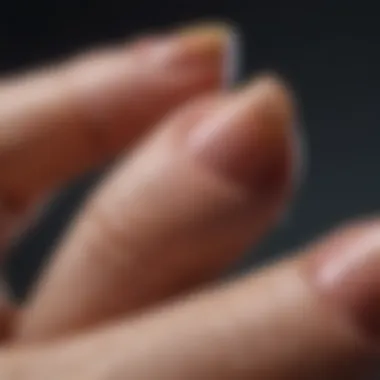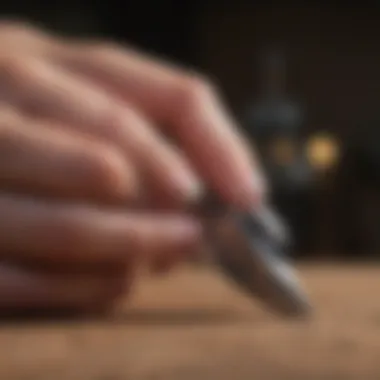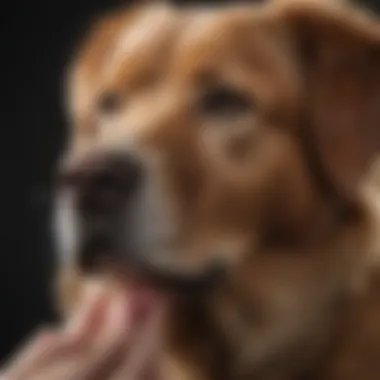Mastering the Art of Holding Your Dog for Nail Cutting: A Comprehensive Guide


Pet Care Essentials
In the realm of pet care essentials, one cannot overlook the significance of maintaining your beloved canine's nails. Daily nutrition requirements and exercise are crucial, but so is grooming. As part of grooming tips, nail trimming stands out for its role in a dog's overall health. Ensuring your canine companion's nails are at an appropriate length is essential for their comfort and mobility. Without proper nail care, dogs can experience pain and even develop mobility issues. Thus, mastering the art of holding your dog during nail trims is a fundamental aspect of responsible pet ownership.
When it comes to small, medium, or large breed dogs, the approach to nail clipping may vary slightly due to differences in anatomy and size. However, the core principles of securely holding your dog remain consistent across all breeds. Providing step-by-step guidance on how to effectively restrain your furry friend during nail trims ensures a stress-free experience for both pet and owner. By understanding the nuances of each breed's behavior and physical characteristics, pet owners can tailor their nail-clipping strategies for optimal results.
Behavior & Training
Understanding your pet's body language is essential for successful nail trimming sessions. Dogs communicate through subtle cues, and being attuned to these signals can help pet owners anticipate any discomfort or anxiety during nail trims. Basic training techniques play a crucial role in preparing your dog for grooming procedures. By gradually introducing your canine to the tools and process of nail trimming, you can help them feel more at ease during the actual clipping.
Furthermore, addressing behavioral concerns such as fear or aggression towards nail clippers is paramount. Implementing positive reinforcement and desensitization strategies can help mitigate these issues over time. Socialization tips also come into play, as well-socialized dogs tend to be more cooperative during grooming routines. By creating positive associations with nail trims and handling, pet owners can foster a trusting relationship with their canine companions.
Pet Home Environment
Creating a pet-friendly space is essential for promoting a positive grooming experience. Establishing a designated grooming area equipped with the necessary tools can streamline the nail-clipping process. Safety measures should be in place to prevent accidents or injuries during trimming sessions. Choosing the right toys and accessories can help distract your dog and make the grooming session more enjoyable for them.
Setting up a comfortable resting area post-trim is also crucial. Providing a cozy spot for your dog to relax after nail clipping can help reduce any residual stress or anxiety. By curating a calming environment for both pre and post-trim stages, pet owners can create a nurturing space that promotes their dog's well-being.
Pet Health Issues
While nail trimming is an essential aspect of canine care, it is also important to be vigilant about potential health issues. Recognizing signs of illness, such as changes in behavior or appetite, can prompt early intervention and prevent further complications. Implementing preventative care measures, including regular vet check-ups and a balanced diet, is key to maintaining your dog's overall health.
Common ailments such as infections or injuries can impact a dog's well-being, emphasizing the importance of prompt treatment. Being prepared for emergencies, including having a first aid kit and knowing basic pet CPR, can make a significant difference in critical situations. By staying informed about common health issues and taking proactive measures, pet owners can safeguard their furry companions' health and longevity.
Introduction
In the realm of responsible pet ownership, one cannot underscore the significance of proper nail care for our canine companions. This article embarks on a meticulous journey delving into the art of holding your dog during nail trimming sessions, elucidating the nuances, complexities, and indispensability of this seemingly routine task. Nail trimming, often neglected or approached with trepidation by many pet owners, is a critical aspect of maintaining a dog's overall well-being and health. The health of a dog's nails impacts not only their comfort and mobility but also their posture and skeletal alignment.


Understanding the absolute necessity of nail trimming sets the tone for this holistic guide, which aims to equip pet owners with the skills and knowledge essential for undertaking this task confidently. Each dog breed, irrespective of size or disposition, warrants specific attention and techniques when it comes to nail care. Beyond physical health, proper nail trimming fosters a robust human-animal bond, nurtured through gentle handling, patience, and skill.
Preparation precedes action, and in the context of nail trimming, it is paramount. The preparation needed encompasses more than just the physical tools; it involves creating a serene environment that facilitates a sense of calmness for both the dog and the handler. Armed with the right tools and a tranquil space, pet owners can approach nail trimming with assurance and poise, laying the groundwork for a successful and stress-free grooming experience.
Furthermore, the act of holding a dog during nail cutting extends far beyond a mere task. It encompasses a multitude of considerations, from understanding the unique anatomical features of each breed to selecting an appropriate holding technique that ensures both safety and comfort. Small breed dogs, medium breeds, and large breeds each demand a tailored approach to holding, taking into account their size, temperament, and susceptibility to stress. By delving into the specifics of holding techniques, pet owners can cultivate a deeper understanding of their dog's individual needs and preferences.
Indeed, the ability to master the art of holding your dog during nail trims transcends the realm of grooming; it speaks to a deeper relationship based on empathy, communication, and trust. This article serves as a guidepost for pet owners seeking to elevate their grooming practices, enrich their bond with their furry companions, and prioritize the health and well-being of their beloved pets.
Understanding the Importance of Nail Trimming
Nail trimming for dogs is an essential aspect of their grooming routine that often gets overlooked by pet owners. Proper nail care is crucial for a dog's overall health and well-being. If left unattended, long nails can cause discomfort, pain, and even lead to health issues such as ingrown nails or joint problems. Maintaining the right nail length is vital for your dog's mobility and comfort.
Regular nail trims also prevent the nails from cracking or splitting, which can be painful for your furry companion. Overgrown nails may affect the way your dog walks, leading to posture issues and potential joint damage over time. Additionally, long nails can get caught in carpets or furniture, causing accidents or injuries to your pet. Therefore, understanding the significance of nail trimming is critical to ensuring your dog's health and safety.
Apart from physical health benefits, regular nail trims can also benefit your dog's emotional well-being. Long nails can make it uncomfortable for a dog to walk or stand, leading to increased stress or anxiety. By keeping your dog's nails at an appropriate length, you can help them move around comfortably and confidently, promoting a positive mental state.
To summarize, nail trimming is not just a superficial grooming task; it is a fundamental aspect of responsible dog ownership. By recognizing the importance of regular nail care, you demonstrate your commitment to your pet's health, happiness, and overall quality of life. Effective nail trimming practices are a cornerstone of pet care, ensuring that your dog remains happy, active, and free from unnecessary pain or discomfort. Remember, a little care in trimming nails can go a long way in maintaining your dog's well-being.
Preparation Before Nail Cutting
Preparation before nail cutting is a crucial aspect of dog grooming that is often overlooked but holds immense significance in ensuring a successful and stress-free nail-trimming session for both you and your furry companion. By meticulously preparing before engaging in the nail cutting process, you can mitigate potential risks and create a comfortable environment that fosters cooperation from your dog. This section aims to delve into the various elements that constitute effective preparation before nail cutting.
Gathering the Necessary Tools
To commence the nail-cutting process, it is imperative to gather the essential tools that will aid in a smooth and efficient trimming experience. Tools such as nail clippers specifically designed for dogs, styptic powder to stop bleeding in case of accidental cuts, and treats for positive reinforcement play a pivotal role in ensuring a successful nail trimming session. Additionally, having a designated area with good lighting and non-slip surfaces further enhances safety and precision during the grooming process.
Creating a Calm Environment


Creating a calm environment is essential not only for the comfort of your dog but also for the effectiveness of the nail cutting session. Dogs are sensitive to their surroundings, and any signs of stress or anxiety can make the process challenging. By selecting a quiet and familiar space free from distractions, you can help your dog relax and feel more at ease during the nail trimming. Soft blankets or mats can provide a comfortable spot for your dog to lie on, further promoting relaxation. Moreover, maintaining a composed and reassuring demeanor yourself can significantly influence your dog's behavior and attitude towards the grooming procedure.
Choosing the Right Holding Technique
When it comes to choosing the right holding technique, several specific elements need consideration. Firstly, the size and breed of the dog play a significant role in determining the most suitable approach. Small breed dogs, medium breed dogs, and large breed dogs each have unique characteristics that must be taken into account when deciding on the best holding technique. Additionally, factors like the dog's temperament, comfort level, and past experiences with nail trimming should also influence the choice of method. By tailoring the holding technique to fit the individual dog's needs, pet owners can streamline the nail cutting process and minimize stress and discomfort.
One of the key benefits of selecting the appropriate holding technique is the ability to maintain control and stability during nail trimming. Dogs can be sensitive to having their paws handled, especially during procedures like nail cutting. By using the right holding technique, pet owners can ensure that their dogs feel secure and well-supported, reducing the likelihood of accidental cuts or injuries. Moreover, a suitable holding method can help prevent excessive fidgeting or resistance from the dog, making the entire process smoother and more efficient.
Overall, the section on choosing the right holding technique is essential for pet owners looking to master the art of holding their dogs during nail trims. By understanding the specific elements, benefits, and considerations related to holding techniques, owners can create a positive and stress-free environment for both themselves and their beloved pets.
Step-By-Step Guide to Holding Your Dog for Nail Trimming
In this vital section focusing on the intricacies of holding your dog during nail trimming, we delve into the crucial elements that ensure a successful and stress-free grooming session. The act of restraining your furry friend properly is not only about safety but also about fostering trust and comfort between you and your pet. Understanding the specifics of how to hold your dog securely can make a significant difference in the overall nail-trimming experience for both you and your beloved companion. Mastering this art is fundamental to maintaining your dog's nail health and overall well-being.
Getting Your Dog Comfortable
When it comes to ensuring your dog's comfort during nail trimming, Building Trust Through Positive Reinforcement plays a pivotal role. This technique entails establishing a positive association with the nail-cutting process by rewarding your dog for calm behavior and gradually introducing them to the tools involved. Building this trust helps alleviate any anxiety or fear your pet may have towards nail trimming, making the experience more manageable and stress-free. While it may take time and patience, the long-term benefits of using this method are invaluable.
Providing treats for your dog creates a positive association with nail trimming, making it a more pleasant experience overall. By offering treats during and after the nail-cutting session, you reinforce good behavior and reward your pet for their cooperation. This positive reinforcement not only helps in getting through the grooming process smoothly but also contributes to strengthening the bond between you and your furry friend.
Proper Restraint Techniques
One effective way to restrain your dog during nail trimming is by using the Scruff Hold Method. This technique involves holding the loose skin on the back of your dog's neck to gently immobilize them, allowing you to work on their nails with ease. The Scruff Hold Method is a popular choice among pet owners as it provides a sense of security for the dog without causing any discomfort or harm.
Utilizing the Sitting Position for Control is another effective restraint method when cutting your dog's nails. By having your dog sit in a controlled position, you can access their paws more easily and ensure stability during the trimming process. This technique offers a sense of structure and authority, reassuring your pet while you attend to their grooming needs.
Maintaining a Calm Demeanor


Avoiding sudden movements is crucial when holding your dog for nail trimming. Sudden gestures or actions can startle your pet and lead to potential accidents or injuries during the grooming process. By maintaining a calm and composed demeanor, you create a sense of tranquility and security for your dog, fostering a more relaxed environment for nail trimming.
Speaking softly to soothe your dog can help alleviate any stress or anxiety they may experience during nail trimming. Dogs are highly attuned to tone and demeanor, so using a gentle and reassuring voice can have a soothing effect and reassure your pet that they are safe. This approach establishes a positive communication channel between you and your dog, enhancing trust and cooperation for future grooming sessions.
Special Considerations for Anxious or Resistant Dogs
Addressing the significant matter of handling anxious or resistant dogs during nail trims is paramount in this comprehensive guide. Anxious dogs present a unique challenge when it comes to nail clipping, as they may exhibit fear or discomfort during the process. Developing strategies to ease their anxieties is crucial for both the dog's well-being and the owner's successful nail-trimming experience. By delving into techniques tailored for anxious or resistant dogs, this article provides a holistic approach to overcoming obstacles that arise in this delicate scenario.
Implementing Desensitization Techniques
Gradual Exposure to Nail Trimming Tools
To acclimatize an anxious dog to the nail-cutting process, gradual exposure to nail trimming tools plays a pivotal role. This method involves introducing the tools in a non-threatening manner, allowing the dog to become familiar with their sight and sound. By slowly integrating the clippers or grinders into the dog's environment without immediate use, the dog begins to associate them with non-invasiveness, reducing fear and apprehension over time. This gradual exposure approach fosters a sense of comfort and familiarity, making the eventual nail-trimming session less stressful for both the dog and the handler.
Rewarding Incremental Progress
Rewarding incremental progress is a fundamental component of desensitizing anxious dogs to nail trims. By positively reinforcing small steps towards accepting the nail trimming process, such as approaching the tools or permitting brief touches on the paws, owners can encourage desired behavior in their pets. Rewarding each achievement with treats or praise establishes a positive association with nail care, reinforcing calm behavior and cooperation. This method values progress over perfection, creating a supportive environment where the dog feels encouraged to overcome their fears gradually.
Seeking Professional Help
Concerned pet owners may benefit significantly from consulting a veterinarian or certified dog trainer when dealing with anxious or resistant dogs during nail trims. Veterinary professionals possess expertise in animal behavior and can offer tailored advice on handling specific anxieties or resistance related to nail clipping. Certified dog trainers bring a wealth of knowledge in behavior modification techniques, providing individualized strategies to address each dog's unique needs. While seeking professional help may incur additional costs, the long-term benefits of expert guidance in managing anxious behavior during nail trimming sessions are invaluable.
Consulting a Veterinarian or Certified Dog Trainer
Relying on the expertise of a veterinarian or certified dog trainer can vastly improve the success rate of nail trims for anxious dogs. These professionals possess the skills to assess a dog's behavior and recommend appropriate desensitization methods or behavior modification strategies. By seeking their guidance, pet owners can ensure a safe and effective approach to nail care, tailored to their dog's specific needs. The insight provided by experts in animal behavior aids in navigating challenges associated with anxious or resistant behavior, fostering a positive experience for both the dog and the owner.
Exploring Behavior Modification Strategies
Behavior modification strategies offer a proactive approach to addressing anxious or resistant behavior in dogs during nail trims. By exploring techniques such as counterconditioning or desensitization, owners can gradually modify their dog's response to nail clipping over time. Behavior modification aims to replace negative associations with positive experiences, promoting relaxation and cooperation during grooming sessions. While implementation may require patience and consistency, the long-term benefits of behavior modification strategies contribute to a harmonious nail-trimming routine, enhancing the overall well-being of the dog.
Conclusion
Nail trimming is an integral aspect of dog grooming and overall health maintenance. The conclusion of this article aims to underscore the significance of mastering the art of holding your dog during nail trims. A well-groomed set of nails not only improves your canine companion's appearance but also contributes to their comfort and well-being. By becoming adept at securely holding your dog during nail clipping sessions, you're not only enhancing their physical health but also fostering trust and a strong bond between you and your furry friend. Understanding the proper techniques for holding your dog can prevent accidents and injuries that may occur during the nail trimming process, ensuring a positive experience for both you and your pet. Consistency in nail care routines can help avoid overgrown nails, which can lead to discomfort and potential health issues in the long run. Therefore, the mastery of holding techniques discussed in this article is a key component of responsible pet ownership. Implementing the tips and strategies outlined here can transform nail trimming from a daunting task into a manageable and stress-free activity for both you and your dog. Nurturing a positive association with nail care through proper holding techniques is not only beneficial for your dog's physical well-being but also promotes a harmonious relationship based on trust and care.







